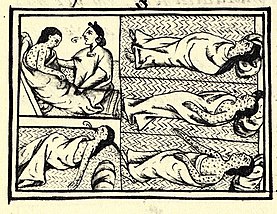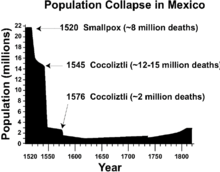Virgin soil epidemic

In epidemiology, a virgin soil epidemic is an epidemic in which populations that previously were in isolation from a pathogen are immunologically unprepared upon contact with the novel pathogen.[1] Virgin soil epidemics have occurred with European colonization, particularly when European explorers and colonists brought diseases to lands they conquered in the Americas, Australia and Pacific Islands.[2]
When a population has been isolated from a particular pathogen without any contact, individuals in that population have not built up any immunity to that organism and also have not received immunity passed from mother to child.[3] The epidemiologist Francis Black has suggested that some isolated populations may not have mixed enough to become as genetically heterogeneous as their colonizers, which would also have affected their natural immunity, due to the potential benefits to immune system function due to genetic diversity.[3] That can happen also when such a considerable amount of time has passed between disease outbreaks that no one in a particular community has ever experienced the disease to gain immunity.[4] Consequently, when a previously unknown disease is introduced to such a population, there is an increase in the morbidity and mortality rates. Historically, that increase has been often devastating and always noticeable.[2]
Diseases introduced to the Americas by Europeans and Africans include smallpox, yellow fever, measles and malaria as well as new strains of typhus and influenza.[5][6]
Virgin soil epidemics also occurred in other regions. For example, the Roman Empire spread smallpox to new populations in Europe and the Middle East in the 2nd century AD, and the Mongol Empire brought the bubonic plague to Europe and the Middle East in the 14th century.[6]

History of the term
The term was coined by Alfred Crosby[1] as an epidemic "in which the populations at risk have had no previous contact with the diseases that strike them and are therefore immunologically almost defenseless." His concept is related to that developed by William McNeill, who connected the development of agriculture and more sedentary life with the emergence of new diseases as microbes moved from domestic animals to humans.[7]
The concept would later be adopted wholesale by Jared Diamond as a central theme in his popular book Guns, Germs and Steel as an explanation for successful European expansion.[8]
Historical instances
Native American epidemics
Due to limited interaction between communities and more limited instances of zoonosis, the spread of infectious diseases was generally hampered in Native American communities. This contrasted with Eurasia, where a large number domesticated animals in close contact with large human populations would lead to more frequent zoonotic diseases, which would then in turn spread between human populations more easily due to trade and warfare. Native Americans were not exposed to this latent pool of circulating Eurasian diseases until the European colonization of the Americas, which then led to frequent virgin soil epidemics among Native Americans.[9]

Cocoliztli epidemics
A series of epidemics of unknown origin caused major population collapses in Central America in the 16th century, possibly due to little immunological protection from previous exposures. While the pathogenic agents of these so-called Cocoliztli epidemics are unidentified, suspected pathogenic agents include endemic viral agents, Salmonella, or smallpox.[10][11]
Australian Aboriginal epidemics
The European colonization of Australia led to major epidemics among Australian Aboriginies, primarily due to smallpox, influenzas, tuberculosis, measles, and potentially chickenpox.[12][13][14]
Other instances
With malaria spreading in the Caribbean islands after European-African contact, the immunological resistance of African slaves to malaria in contrast to the immunologically defenseless locals might have contributed to African slave trade.[15]
Novel and rapid-spreading pandemics such as the Spanish flu are occasionally referred to as virgin soil pandemics.[16]
Debate
Research over the last few decades has questioned some aspects of the notion of virgin soil epidemics. David S. Jones has argued that the term "virgin soil" is often used to describe a genetic predisposition to disease infection and that it obscures the more complex social, environmental, and biological factors that can enhance or reduce a population's susceptibility.[8]
Paul Kelton has argued that the slave trade in indigenous people by Europeans exacerbated the spread and virulence of smallpox and that a virgin soil model alone cannot account for the widespread disaster of the epidemic.[17]
The debate, as regards smallpox (Variola major or Variola minor), is sometimes complicated by problems in distinguishing its effects from those of other diseases that could prove fatal to virgin soil populations, most notably chickenpox.[18] Thus, the famous virologist Frank Fenner, who played a major role in the worldwide elimination of smallpox, remarked in 1985,[19] "Retrospective diagnosis of cases or outbreaks of disease in the distant past is always difficult and to some extent speculative."
Cristobal Silva has re-examined accounts by colonists of 17th-century New England epidemics and has interpreted and argued that they were products of particular historical circumstances, rather than universal or genetically inevitable processes.[20][21]
Historian Gregory T. Cushman claims that virgin soil epidemics were not the major cause of deaths due to disease among Pacific Island populations. Rather, diseases like tuberculosis and dysentery were able to take hold in Pacific Island populations that had weakened immune systems because of overworking and exploitation by European colonizers.[22]
Historian Christopher R. Browning writes that "Disease, colonization, and irreversible demographic decline were intertwined and mutually reinforcing" in reference to virgin soil epidemics during the European colonisation of the Americas. He contrasts the rebound of the European population following the Black Death with the lack of such a rebound across most Native American populations, attributing this differing demographic trend to the fact that Europeans were not exploited, enslaved, and massacred in the aftermath of the Black Death like the indigenous inhabitants of the New World were. "Disease as the chief killing agent," he writes, "does not remove settler colonialism from the rubric of genocide".[23]
Following this work, historian Jeffrey Ostler has argued that, in relation to European colonization of the Americas, "virgin soil epidemics did not occur everywhere and ... Native populations did not inevitably crash as a result of contact. Most Indigenous communities were eventually afflicted by a variety of diseases, but in many cases this happened long after Europeans first arrived. When severe epidemics did hit, it was often less because Native bodies lacked immunity than because European colonialism disrupted Native communities and damaged their resources, making them more vulnerable to pathogens."[24]
See also
- Columbian Exchange
- Ecological imperialism
- Influx of disease in the Caribbean
- Seasoning (colonialism)
- Native American disease and epidemics
- Millenarianism in colonial societies
- Cocoliztli epidemics
References
- Footnotes
- ^ a b Crosby, Alfred W. (1976). "Virgin Soil Epidemics as a Factor in the Aboriginal Depopulation in America". The William and Mary Quarterly. 33 (2): 289–299. doi:10.2307/1922166. ISSN 0043-5597. JSTOR 1922166. PMID 11633588.
- ^ a b Cliff et al, p. 120
- ^ a b Hays, p. 87
- ^ Daschuk, James (2013). Clearing the Plains: Disease, Politics of Starvation and the Loss of Aboriginal Life. Regina: University of Regina Press. pp. 11–12. ISBN 9780889772960.
- ^ Crosby, Alfred W. (1976), "Virgin Soil Epidemics as a Factor in the Aboriginal Depopulation in America", The William and Mary Quarterly, 33 (2), Omohundro Institute of Early American History and Culture: 289–299, doi:10.2307/1922166, JSTOR 1922166, PMID 11633588
- ^ a b Alchon, p. 80
- ^ McNeill, William H. (1976), Plagues and Peoples, Anchor Press, ISBN 978-0385121224
- ^ a b Jones, David (2003). "Virgin Soils Revisited". The William and Mary Quarterly. 60 (4): 703–742. doi:10.2307/3491697. JSTOR 3491697.
- ^ Francis, John M. (2005). Iberia and the Americas culture, politics, and history: A Multidisciplinary Encyclopedia. Santa Barbara, California: ABC-CLIO.
- ^ Vågene, Åshild J.; Herbig, Alexander; Campana, Michael G.; Robles García, Nelly M.; Warinner, Christina; Sabin, Susanna; Spyrou, Maria A.; Andrades Valtueña, Aida; Huson, Daniel; Tuross, Noreen; Bos, Kirsten I.; Krause, Johannes (March 2018). "Salmonella enterica genomes from victims of a major sixteenth-century epidemic in Mexico". Nature Ecology & Evolution. 2 (3): 520–528. doi:10.1038/s41559-017-0446-6. ISSN 2397-334X. PMID 29335577. S2CID 256726167.
- ^ Acuna-Soto, Rodolfo (April 2002). "Megadrought and Megadeath in 16th Century Mexico". Emerging Infectious Diseases. 8 (4): 360–362. doi:10.3201/eid0804.010175. PMC 2730237. PMID 11971767.
- ^ Dowling, Peter (2021). Fatal contact: How epidemics nearly wiped out Australia's first peoples. Clayton, Victoria: Monash University Publishing. ISBN 9781922464460.
- ^ Hunter, Boyd H.; Carmody, John (July 2015). "Estimating the Aboriginal Population in Early Colonial Australia: The Role of Chickenpox Reconsidered: Aborigines in early colonial Australia". Australian Economic History Review. 55 (2): 112–138. doi:10.1111/aehr.12068.
- ^ Dowling, Peter. “‘A Great Deal of Sickness’: Introduced Diseases among the Aboriginal People of Colonial Southeast Australia,” 1997.
- ^ Esposito, Elena (2015). "Side effects of immunities : the African slave trade". hdl:1814/36118. ISSN 1830-7728.
{{cite journal}}: Cite journal requires|journal=(help) - ^ Carpenter, Connie; Sattenspiel, Lisa (2009). "The design and use of an agent-based model to simulate the 1918 influenza epidemic at Norway House, Manitoba". American Journal of Human Biology. 21 (3): 290–300. doi:10.1002/ajhb.20857. ISSN 1520-6300. PMID 19107906. S2CID 20066083.
- ^ Kelton, Paul (2007). Epidemics and Enslavement: Biological Catastrophe in the Native Southeast, 1492-1715. Omaha: University of Nebraska Press.
- ^ There is detailed discussion of the difficulty of making this distinction on one continent at https://en.wikipedia.org/wiki/Smallpox_in_Australia#Unresolved_Issues_in_the_Chickenpox_Debate and https://en.wikipedia.org/wiki/Smallpox_in_Australia#Smallpox_and_chickenpox:_confused_yet_distinct
- ^ Hingston, Richard G.; Fenner, Frank (1985). "Smallpox in Australia". Medical Journal of Australia. 142 (4): 278. doi:10.5694/j.1326-5377.1985.tb113338.x. PMID 3883104.
- ^ Silva, Cristobal (2011). Miraculous Plagues: An Epidemiology of Early New England Narrative. Oxford, U.K.: Oxford University Press.
- ^ Rice, James D. (2014). "Beyond "The Ecological Indian" and "Virgin Soil Epidemics": New Perspectives on Native Americans and the Environment". History Compass. 12 (9): 747–757. doi:10.1111/hic3.12184 – via Wiley-Blackwell Journals (Frontier Collection).
- ^ Cushman, Gregory T. (2013). Guano and the Opening of the Pacific World. Cambridge University Press. p. 78. ISBN 9781139047470.
- ^ Browning, Christopher R. (February 8, 2022). "Yehuda Bauer, the Concepts of Holocaust and Genocide, and the Issue of Settler Colonialism". The Journal of Holocaust Research. 36 (1): 30–38. doi:10.1080/25785648.2021.2012985. S2CID 246652960. Retrieved April 30, 2022.
- ^ Ostler, Jeffrey (2019). Surviving Genocide: Native Nations and the United States from the American Revolution to Bleeding Kansas. Yale University Press. pp. 12–13.
- Bibliography
- Alchon, Suzanne Austin (2003), A Pest in the Land: New World Epidemics in a Global Perspective, University of New Mexico Press, ISBN 0-8263-2871-7
- Cliff, Andrew David; Haggett, Peter; Smallman-Raynor, Matthew (2000), Island Epidemics, Oxford University Press, ISBN 0-19-828895-6
- Hays, J. N. (2005), Epidemics and Pandemics: Their Impacts on Human History, ABC-CLIO, ISBN 1-85109-658-2
